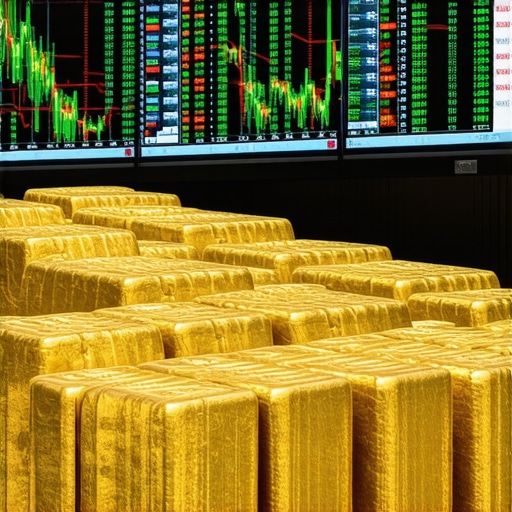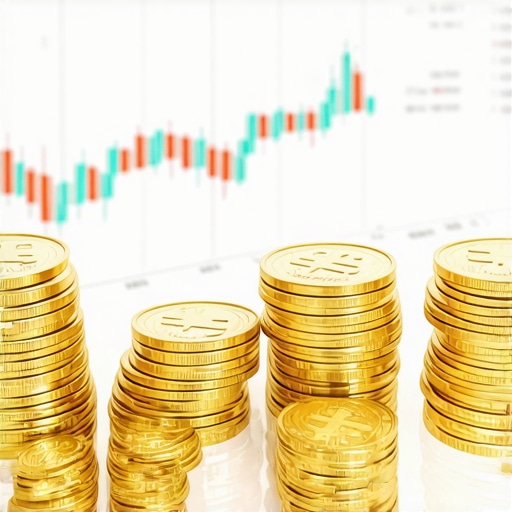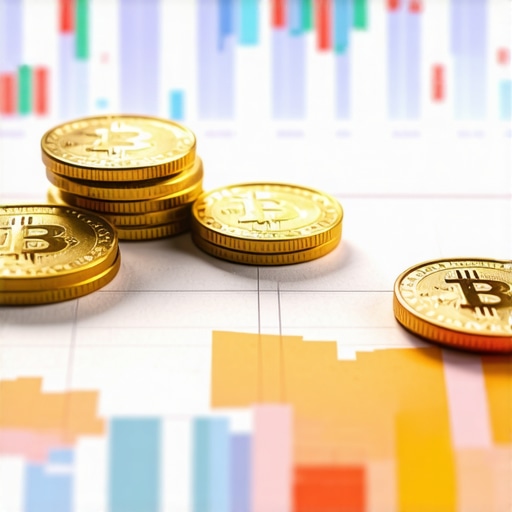Understanding the Strategic Role of Central Bank Gold Purchases in 2025
As global financial landscapes evolve, the behavior of central banks regarding gold reserves has become a critical indicator for investors and market analysts alike. In 2025, the volume and strategic timing of central bank gold acquisitions are poised to significantly influence gold market prices, shaping investment strategies and portfolio diversification approaches. This article delves into the complex mechanics behind these purchases and their projected impact on the gold market, emphasizing the importance of nuanced analysis rooted in macroeconomic and geopolitical contexts.
Decoding the Motivation: Why Are Central Banks Increasing Gold Reserves?
Central banks’ decisions to purchase gold are often driven by a confluence of factors—rising inflation, geopolitical tensions, and a desire to hedge against currency devaluation. According to a recent white paper by the World Gold Council, the strategic accumulation of gold serves as a safeguard against the unpredictable nature of fiat currencies, especially in an era marked by economic uncertainty. By examining the historical trends and current policies, we see a deliberate shift towards gold as a reserve asset, signaling a potential stabilization or upward trajectory in prices.
How Will These Purchases Shape the Gold Price Trajectory in 2025?
The influence of central bank gold purchases on market prices is multifaceted. Their actions can create upward pressure by reducing available supply in the market, especially if these acquisitions are substantial. Moreover, the timing of these purchases—whether they occur during periods of market volatility or economic stability—can amplify price movements. Expert forecasts, such as those discussed in Gold Price Forecasts for 2025, suggest a potential rally driven by these strategic reserves, especially if accompanied by increased demand from investors seeking safe haven assets.
What are the implications of these central bank activities for retail and institutional investors?
Investors must consider the ripple effects of central bank activities, including potential surges in gold prices and increased market volatility. It is advisable to explore diversification strategies, such as allocating assets into physical gold, ETFs, or gold mining stocks, as outlined in top gold stocks to watch in 2025. Moreover, understanding the nuances of market timing and geopolitical risk can enhance portfolio resilience in the face of fluctuating central bank policies.
For those seeking a comprehensive understanding of safe gold investment practices, the ultimate guide to buying gold safely in 2025 offers strategic insights and practical tips.
As the year progresses, continuous monitoring of central bank reports and macroeconomic indicators will be crucial. Staying informed through expert analyses and market intelligence can empower investors to make data-driven decisions and capitalize on emerging opportunities in the evolving gold landscape.
In conclusion, the strategic gold purchases by central banks in 2025 are set to be a defining factor in the future trajectory of gold prices. Recognizing the underlying motivations and market implications enables investors to adapt their strategies proactively, ensuring long-term wealth preservation and growth.
Deciphering Central Bank Gold Accumulation: A Game Changer for 2025
As central banks continue to bolster their gold reserves, understanding the underlying motivations and potential market implications becomes essential for savvy investors. The deliberate increase in gold holdings signals a strategic shift towards diversification and risk mitigation amid geopolitical tensions and economic uncertainties. According to a comprehensive report by the World Gold Council, these activities are not merely reserve management but also a response to the evolving macroeconomic landscape, making them a critical factor in shaping the 2025 gold market trajectory.
How Will Central Bank Strategies Influence Gold Price Dynamics in 2025?
Central bank gold purchases tend to create a bullish outlook, especially when large-scale acquisitions coincide with market volatility. Such activity often reduces available supply, exerting upward pressure on prices. Additionally, timing plays a pivotal role—purchases during periods of economic stability may reinforce confidence, while those during turbulence could amplify volatility. Market forecasts, like those found in Gold Price Forecasts for 2025, suggest a potential rally driven by these strategic reserves, compounded by increasing demand from investors seeking safe-haven assets amidst geopolitical and economic uncertainties.
Can retail investors leverage central bank moves to optimize their gold investments?
Absolutely. Recognizing the signals from central bank activities enables investors to anticipate price movements and adjust their portfolios accordingly. Diversification remains key—allocating assets into physical gold, ETFs, or gold mining stocks, as discussed in top gold stocks to watch in 2025, can enhance resilience against market fluctuations. Furthermore, staying informed through expert analyses and macroeconomic indicators can help in timing entry and exit points effectively, maximizing returns while minimizing risks.
For practical guidance on safe gold investing, the ultimate guide to buying gold safely in 2025 provides valuable insights into selecting reputable dealers and securing authentic assets.
Monitoring central bank reports and global economic developments will be vital throughout 2025. Utilizing advanced tools like technical analysis and market intelligence can empower investors to navigate emerging opportunities and mitigate potential pitfalls in the evolving gold landscape.
What are the long-term implications of rising central bank gold reserves for global monetary stability?
The accumulation of gold by central banks hints at a broader shift in global monetary policy, possibly signaling a move away from reliance on fiat currencies towards a more asset-backed approach. This trend could influence currency valuations, inflation expectations, and international trade dynamics. Experts like those at the World Gold Council emphasize that sustained central bank buying may underpin gold prices in the long term, reinforcing gold’s role as a cornerstone of financial security.
For investors aiming to build resilience, exploring diverse gold investment vehicles such as ETFs, coins, bars, and gold IRAs, as outlined in developing a long-term gold investment portfolio, is recommended. Integrating these strategies within a comprehensive financial plan can safeguard wealth against the volatility of modern markets.
Stay engaged with expert insights and market updates—sharing your thoughts or asking questions can foster a deeper understanding of this evolving landscape. For more advanced strategies, consider exploring futures and technical analysis techniques to refine your investment approach in 2025 and beyond.
Unraveling the Geopolitical Chessboard: How Central Bank Gold Purchases Signal Global Monetary Shifts
In 2025, the deliberate accumulation of gold reserves by central banks is more than mere reserve management; it reflects a nuanced geopolitical strategy aimed at ensuring monetary stability amidst volatile international relations. These strategic purchases often coincide with shifts in diplomatic alignments or economic sanctions, acting as subtle yet potent signals to markets and geopolitical actors. According to a comprehensive analysis by the World Gold Council, the pattern of central bank buying is increasingly aligned with geopolitical resilience, serving as a form of soft power reinforcement. This trend underscores gold’s evolving role as a safeguard against not only economic instability but also geopolitical upheaval.
Advanced Market Dynamics: How Do Central Bank Purchases Influence Gold Price Volatility?
The influence of central bank gold acquisitions on market volatility is multifaceted, extending beyond simple supply-demand mechanics. Large-scale purchases tend to create a ‘price anchor,’ reducing liquidity and amplifying market reactions to geopolitical or macroeconomic shocks. Moreover, the timing of these purchases—often orchestrated during periods of market calm—can paradoxically set the stage for sharper price movements once the market perceives shifts in central bank reserves. Recent research from the Financial Markets Analysis Institute suggests that such strategic accumulation can lead to increased speculative activity, as traders anticipate future price surges driven by central bank activity. This interplay amplifies the importance for institutional investors to deploy sophisticated hedging strategies, including options and futures, to mitigate potential risks.
What sophisticated hedging techniques are most effective for institutional investors amid central bank-driven volatility?
Institutional investors benefit from employing a blend of options strategies, such as protective puts and call spreads, alongside dynamic portfolio rebalancing based on real-time macroeconomic indicators. Utilizing algorithmic trading models that incorporate machine learning to predict central bank activity patterns can provide a competitive edge. For example, integrating sentiment analysis from geopolitical news feeds with technical analysis of gold price momentum enables proactive positioning. According to Hedge Funds Review, these advanced techniques are increasingly vital in navigating the complex web of market influences, especially when central banks’ actions are unpredictable or covert.
For investors eager to deepen their understanding, engaging with specialized financial analytics firms and subscribing to expert market intelligence reports can be invaluable. Exploring tools such as predictive analytics platforms that combine macroeconomic data, geopolitical risk assessments, and technical indicators can significantly enhance decision-making agility in this volatile environment.
Emerging Trends: The Role of Digital Gold and Blockchain in Central Bank Reserves
One of the most fascinating developments in the realm of gold reserves is the integration of digital gold and blockchain technology by some central banks. This innovation aims to improve transparency, streamline transactions, and reduce costs associated with physical gold storage. According to a report by Cryptocurrency News, a handful of progressive central banks are experimenting with digital representations of gold reserves, potentially setting a precedent for future reserve management. These digital assets could facilitate rapid, secure transfers across borders, and provide real-time visibility into reserve holdings, thereby enhancing strategic flexibility.

As this technology matures, it may redefine how central banks interact with gold markets, introducing a new layer of digital sovereignty and operational efficiency. For investors, understanding these technological shifts is crucial, as they could impact gold’s liquidity profile and its role as a global reserve asset. Deep engagement with emerging fintech solutions and regulatory developments will be essential for those seeking to anticipate market transformations and leverage new opportunities.
Conclusion: Preparing for a Gold-Driven Monetary Shift in 2025 and Beyond
The strategic gold acquisitions by central banks in 2025 are not isolated phenomena but part of a broader transformation in global monetary policy and geopolitical resilience. Recognizing the sophisticated motives behind these moves—ranging from economic safeguarding to geopolitical signaling—equips investors with a nuanced perspective necessary for long-term strategic planning. As markets evolve, staying ahead requires not only monitoring central bank reports and macroeconomic indicators but also embracing technological innovations like digital gold and advanced hedging strategies.
To deepen your understanding and refine your investment approach, consider consulting with financial experts specializing in macroeconomic and geopolitical analysis. Continuous education and proactive engagement are your best tools for navigating the complexities of the 2025 gold landscape and capitalizing on emerging opportunities in this dynamic environment.
Unveiling the Hidden Dynamics of Central Bank Gold Strategies in 2025
As the geopolitical landscape becomes increasingly complex, central banks are adopting sophisticated tactics to bolster their gold reserves, signaling a paradigm shift in global monetary stability. These maneuvers, often cloaked in strategic opacity, serve not only as a hedge against currency volatility but also as a geopolitical tool of soft power. According to a detailed report by the World Gold Council, the pattern of accumulating gold reserves underscores a deliberate move towards diversification and resilience, hinting at a potential redefinition of international monetary norms.
How Are Central Bank Activities Reshaping Gold Price Volatility and Market Dynamics?
Strategic acquisitions by central banks influence gold markets through multifaceted channels. Large-scale purchases tend to exert upward pressure on prices, especially when synchronized with periods of economic uncertainty, thus reducing liquidity and amplifying market reactions. The timing and scale of these purchases are crucial—buying during calm periods often sets a bullish tone, while during turbulence, it can trigger heightened volatility. Research from the Financial Markets Analysis Institute reveals that such activities can induce speculative behaviors, demanding advanced hedging strategies from institutional investors to mitigate risks. This dynamic underscores the importance of deploying options, futures, and algorithmic trading tools tailored to anticipate central bank moves.
What cutting-edge hedging techniques can institutional investors employ to navigate this volatile environment?
Institutional investors are increasingly leveraging sophisticated instruments like protective puts, collar strategies, and delta-neutral portfolios, often integrated with machine learning-driven predictive analytics. These approaches enable proactive positioning relative to anticipated central bank activities. For example, combining sentiment analysis of geopolitical news with technical trend indicators provides a nuanced forecasting framework. As outlined in Hedge Funds Review, such methodologies are vital for managing exposure in an environment characterized by opacity and rapid shifts. Engagement with specialized analytics firms and subscription to real-time market intelligence platforms can further enhance decision-making agility.
Explore the latest in hedging innovations and refine your risk management arsenal to stay ahead in this evolving landscape.
Emerging Technologies: Digital Gold and Blockchain as Central Bank Game-Changers
The advent of digital gold and blockchain integration marks a revolutionary development in reserve management. Central banks experimenting with these technologies aim to enhance transparency, reduce transaction costs, and streamline cross-border transfers. A recent report by Cryptocurrency News highlights early pilots where digital representations of gold reserves facilitate real-time access and operational efficiency, potentially setting new global standards. This evolution may transform traditional perceptions of gold’s liquidity and security, opening avenues for innovative financial instruments and reserve strategies.

Understanding these technological shifts is crucial for investors contemplating gold’s future role. Embracing fintech advancements, coupled with regulatory foresight, can position market participants to leverage digital gold’s full potential, ensuring resilience amidst rapid digital transformation.
The Long Arc: How Central Bank Gold Accumulation Shapes Global Monetary Architecture
The sustained increase in central bank gold holdings signifies more than tactical reserve building; it heralds a strategic move towards a potential reimagining of global monetary systems. Experts from the World Gold Council suggest that this trend could underpin a shift away from fiat dependency, fostering a more asset-backed monetary framework. Such a transition may influence currency valuations, inflation expectations, and international trade flows, ultimately reinforcing gold’s position as a cornerstone of financial stability.
For investors, diversifying into physical gold, ETFs, and gold-backed IRAs, as detailed in developing a long-term gold investment portfolio, remains a prudent strategy. Integrating these assets into comprehensive financial plans can safeguard wealth against the volatility of modern markets, emphasizing resilience and long-term growth.
Strategic Implications: How Geopolitical Tensions Drive Gold Reserve Policies
In 2025, gold reserves are increasingly viewed through the lens of geopolitical resilience. Central banks’ responses to international tensions, sanctions, and diplomatic realignments often manifest as rapid accumulation of gold assets, serving as a buffer against economic sanctions or currency destabilization. The World Gold Council indicates that these maneuvers are not merely defensive but also strategic signals to the global community, emphasizing gold’s role as a form of monetary sovereignty and soft power.
Investors seeking to decode these signals should monitor geopolitical developments, reserve reports, and central bank communications closely. Building a diversified gold portfolio with physical assets, digital tokens, and futures contracts can provide strategic agility and resilience in uncertain times.
Expert Insights & Advanced Considerations
1. Central Bank Diversification Strategies Are Evolving
Leading economists observe that central banks are increasingly diversifying their reserves with gold, signaling a strategic shift towards asset-backed stability amid geopolitical tensions and currency volatility. This trend underscores gold’s role as a safeguard against fiat currency devaluation and highlights the importance of monitoring reserve reports for informed investment decisions.
2. Market Volatility Will Be Amplified by Strategic Gold Acquisitions
As central banks execute large-scale gold purchases, expect heightened market volatility, especially during periods of economic uncertainty. Sophisticated traders and institutional investors should employ advanced hedging techniques such as options and futures to mitigate risk and capitalize on price movements driven by these strategic activities.
3. Digital Gold and Blockchain Are Reshaping Reserve Management
Innovations like digital gold tokens and blockchain technology are enhancing transparency and operational efficiency for central banks. Staying abreast of these technological shifts enables investors to anticipate emerging liquidity trends and potential impacts on gold’s role as a global reserve asset.
4. Geopolitical Signaling Through Gold Accumulation Is Increasing
Central banks are increasingly using gold reserves as a geopolitical signal, reinforcing monetary sovereignty amidst international tensions. Recognizing these signals through geopolitical analysis can provide strategic advantages for investors seeking to align their portfolios with global monetary shifts.
5. Long-Term Implications Indicate a Potential Shift Toward Asset-Backed Monetary Systems
The sustained accumulation of gold reserves suggests a move toward a more asset-backed global monetary framework, which could influence currency valuations, inflation expectations, and international trade flows. Diversifying holdings with physical gold, ETFs, and retirement accounts can hedge against these macroeconomic changes.
Curated Expert Resources
- World Gold Council: Offers comprehensive reports and analysis on central bank gold reserve trends, essential for understanding macroeconomic and geopolitical influences.
- Hedge Funds Review: Provides insights into advanced hedging strategies like options and algorithmic trading, vital for institutional risk management.
- Cryptocurrency News: Features updates on digital gold and blockchain innovations, crucial for understanding technological impacts on reserve management.
- Financial Markets Analysis Institute: Delivers research on market dynamics and volatility caused by strategic central bank activities.
- Government and Central Bank Reports: Primary sources for official reserve data and policy signals, indispensable for strategic planning.
Final Expert Perspective
In the evolving landscape of 2025, the strategic gold purchases by central banks are more than mere reserve adjustments—they reflect a profound shift towards geopolitical resilience and monetary stability. Recognizing these high-level dynamics enables investors to position their portfolios proactively, leveraging technological innovations and macroeconomic insights. Engaging with authoritative resources and expert analysis ensures that your strategies remain robust amidst uncertainty. Dive deeper, share your insights, or explore advanced forecasting tools to stay ahead in this complex environment—your expertise is your greatest asset in navigating the future of gold markets.










